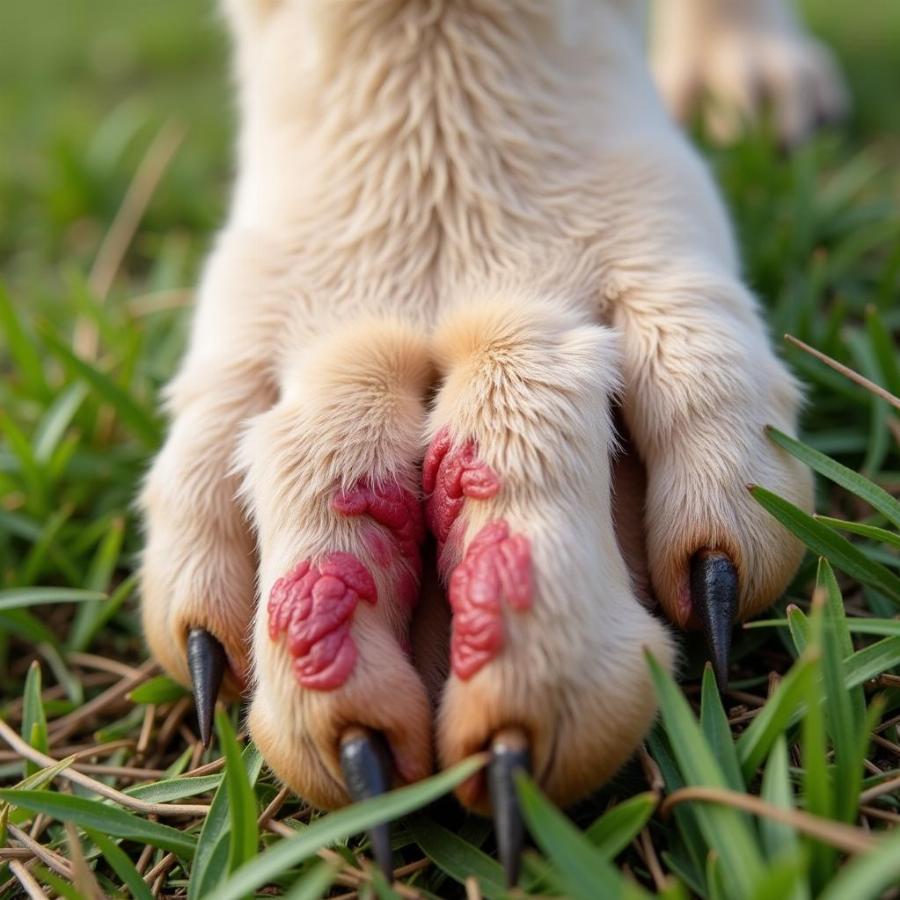As a loving dog owner, you want to protect your furry friend from any harm, but sometimes dangers hide in plain sight, like poison ivy. While we may recognize the itchy rash it causes on ourselves, identifying it on our canine companions can be tricky. That’s where “dog poison ivy pictures” come in handy. Recognizing the signs early can make a world of difference in your pup’s recovery.
Can Dogs Get Poison Ivy?
Technically, no, dogs can’t get poison ivy in the same way humans do. We develop an allergic reaction to urushiol, an oily resin found in poison ivy, oak, and sumac. Luckily, our canine companions have a layer of fur that usually protects their skin from this pesky oil.
So, What’s With the Itch?
While your dog might not break out in a rash, they can still react to urushiol. Instead of a rash, they might experience:
- Redness and inflammation: Look for these signs on areas with less fur like the belly and paws.
- Intense itching: You might notice your dog scratching more than usual, even excessively licking or chewing at their skin.
- Blisters: In some cases, small, fluid-filled blisters can develop.
Spotting the Culprit: Is it Poison Ivy?
It’s easy to jump to conclusions when your dog is uncomfortable, but remember that other conditions can cause similar symptoms. Flea bites, allergies, and other skin irritations can mimic a poison ivy reaction.
 Dog Paw with Redness
Dog Paw with Redness
My Dog Might Have Poison Ivy, Now What?
If you suspect your dog has come into contact with poison ivy, don’t panic. Here’s what you can do:
- Don’t touch them directly: Urushiol can transfer to your skin. Wear gloves or use a towel to protect yourself.
- Give them a bath: Use cool water and a gentle oatmeal-based dog shampoo to wash away any lingering oil. Be sure to thoroughly clean any areas that might have touched the plant.
- Soothe the itch: Apply a cool compress or a paste of baking soda and water to the affected areas to relieve itching.
- Call your vet: It’s always best to err on the side of caution. Your vet can assess the situation, rule out other conditions, and recommend the best course of treatment.
Preventing Future Encounters
The best way to deal with poison ivy is to avoid it altogether:
- Learn to identify it: Familiarize yourself and your family with what poison ivy looks like. Remember the saying, “Leaves of three, let it be.”
- Keep your dog leashed: When walking in wooded areas, keep your dog on a leash to prevent them from wandering into poison ivy patches.
- Consider a barrier spray: There are pet-safe sprays available that create a barrier on your dog’s fur, making it harder for urushiol to penetrate.
When in Doubt, Call the Experts
Remember, “dog poison ivy pictures” can be a helpful tool for initial assessment, but they shouldn’t replace professional advice. If your dog is showing any signs of discomfort, don’t hesitate to reach out to your veterinarian. Early intervention is key to ensuring your furry friend makes a full recovery.
FAQs:
Can I get poison ivy from my dog?
Yes, you can get poison ivy indirectly from your dog if you touch the urushiol oil on their fur before it’s washed off.
How long does it take for poison ivy to show up on a dog?
Similar to humans, symptoms can appear anywhere from a few hours to a few days after exposure.
What if my dog ate poison ivy?
While rare, it’s possible. Contact your vet immediately if you suspect your dog has ingested any part of the poison ivy plant.
Are there any home remedies for dog poison ivy?
Oatmeal baths and cool compresses can provide relief, but always consult with your vet before trying any home remedies.
What does a poison ivy rash on a dog look like?
Dogs don’t typically develop the classic rash like humans. Instead, look for redness, inflammation, and signs of intense itching.
Need More Help?
Beaut Dogs is your go-to source for all things dog-related. We offer a wealth of information on dog breeds, care, and well-being. For detailed guidance and expert advice on keeping your furry friend happy and healthy, contact us at [email protected].